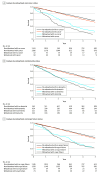Mortality and Function After Widowhood Among Older Adults With Dementia, Cancer, or Organ Failure
- PMID: 39264625
- PMCID: PMC11393717
- DOI: 10.1001/jamanetworkopen.2024.32979
Mortality and Function After Widowhood Among Older Adults With Dementia, Cancer, or Organ Failure
Abstract
Importance: The widowhood effect, in which mortality increases and function decreases in the period following spousal death, may be heightened in older adults with functional impairment and serious illnesses, such as cancer, dementia, or organ failure, who are highly reliant on others, particularly spouses, for support. Yet there are limited data on widowhood among people with these conditions.
Objective: To determine the association of widowhood with function and mortality among older adults with dementia, cancer, or organ failure.
Design, setting, and participants: This longitudinal cohort study used population-based, nationally representative data from the Health and Retirement Study database linked to Medicare claims from 2008 to 2018. Participants were married or partnered community-dwelling adults aged 65 years and older with and without cancer, organ failure, or dementia and functional impairment (function score <9 of 11 points), matched on widowhood event and with follow-up until death or disenrollment. Analyses were conducted from September 2021 to May 2024.
Exposure: Widowhood.
Main outcomes and measures: Function score (range 0-11 points; 1 point for independence with each activity of daily living [ADL] or instrumental activity of daily living [IADL]; higher score indicates better function) and 1-year mortality.
Results: Among 13 824 participants (mean [SD] age, 70.1 [5.5] years; 6416 [46.4%] female; mean [SD] baseline function score, 10.2 [1.6] points; 1-year mortality: 0.4%) included, 5732 experienced widowhood. There were 319 matched pairs of people with dementia, 1738 matched pairs without dementia, 95 matched pairs with cancer, 2637 matched pairs without cancer, 85 matched pairs with organ failure, and 2705 matched pairs without organ failure. Compared with participants without these illnesses, widowhood was associated with a decline in function immediately following widowhood for people with cancer (change, -1.17 [95% CI, -2.10 to -0.23] points) or dementia (change, -1.00 [95% CI, -1.52 to -0.48] points) but not organ failure (change, -0.84 [95% CI, -1.69 to 0.00] points). Widowhood was also associated with increased 1-year mortality among people with cancer (hazard ratio [HR], 1.08 [95% CI, 1.04 to 1.13]) or dementia (HR, 1.14 [95% CI, 1.02 to 1.27]) but not organ failure (HR, 1.02 [95% CI, 0.98 to 1.06]).
Conclusions and relevance: This cohort study found that widowhood was associated with increased functional decline and increased mortality in older adults with functional impairment and dementia or cancer. These findings suggest that persons with these conditions with high caregiver burden may experience a greater widowhood effect.
Conflict of interest statement
Figures


References
-
- AARP Public Police Institute; National Alliance for Caregiving . Caregiving in the U.S. Accessed December 19, 2023. https://www.caregiving.org/wp-content/uploads/2020/05/2015_Caregivingint...
-
- National Center for Health Statistics . Leading causes of death, United States 2021. Accessed March 11, 2024. https://www.cdc.gov/nchs/fastats/leading-causes-of-death.htm
Publication types
MeSH terms
Grants and funding
LinkOut - more resources
Full Text Sources
Medical

